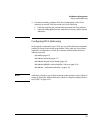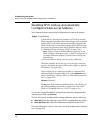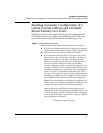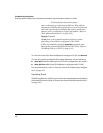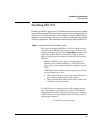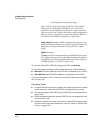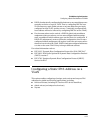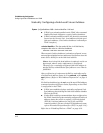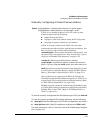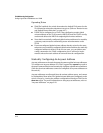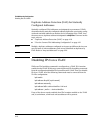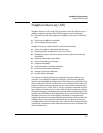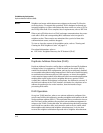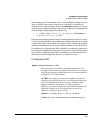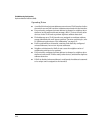
4-13
IPv6 Addressing Configuration
Configuring a Static IPv6 Address on a VLAN
Statically Configuring A Global Unicast Address
To view the currently configured static IPv6 addresses per-VLAN, use show run.
To view all currently configured IPv6 unicast addresses, use the following:
■ show ipv6 (Lists IPv6 addresses for all VLANs configured on the switch.)
■ show ipv6 vlan < vid > (Lists IPv6 addresses configured on VLAN < vid >.)
For more information, refer to “View the Current IPv6 Addressing Configura-
tion” on page 4-21.
Syntax:.
[no] ipv6 address < network-prefix><device-id >/< prefix-length >
[no] ipv6 address < network-prefix>::/< prefix-length > eui-64
If IPv6 is not already enabled on a VLAN, either of these
command options do the following:
■ enable IPv6 on the VLAN
■ configure a link-local address using the EUI-64 format
■ statically configure a global unicast address
If IPv6 is already enabled on the VLAN, then the above
commands statically configure a global unicast address, but
have no effect on the current link-local address.
< network-prefix >: This includes the global routing prefix and
the subnet ID for the address. For more on this topic, refer to
“Prefixes in Routable IPv6 Addresses” on page 3-18.
< device-id >: Enters a user-defined device identity.
< prefix-length >: Specifies the number of bits in the network
prefix. If you are using the eui-64 option, this value must be 64.
eui-64: Specifies using the Extended Unique Identifier format
to create a device identifier based on the VLAN MAC address.
Refer to “Extended Unique Identifier (EUI)” on page 3-14.
After verification of uniqueness by DAD, the lifetime of a
statically configured IPv6 address assigned to a VLAN is set
to permanent, and is configured as a preferred address. (Refer
to “IPv6 Address Deprecation” on page 3-25.)
The no form of the command erases the specified address and,
if no other IPv6-enabling command is configured on the VLAN,
disables IPv6 on the VLAN. (Refer to “Disabling IPv6 on a
VLAN” on page 4-16.)



